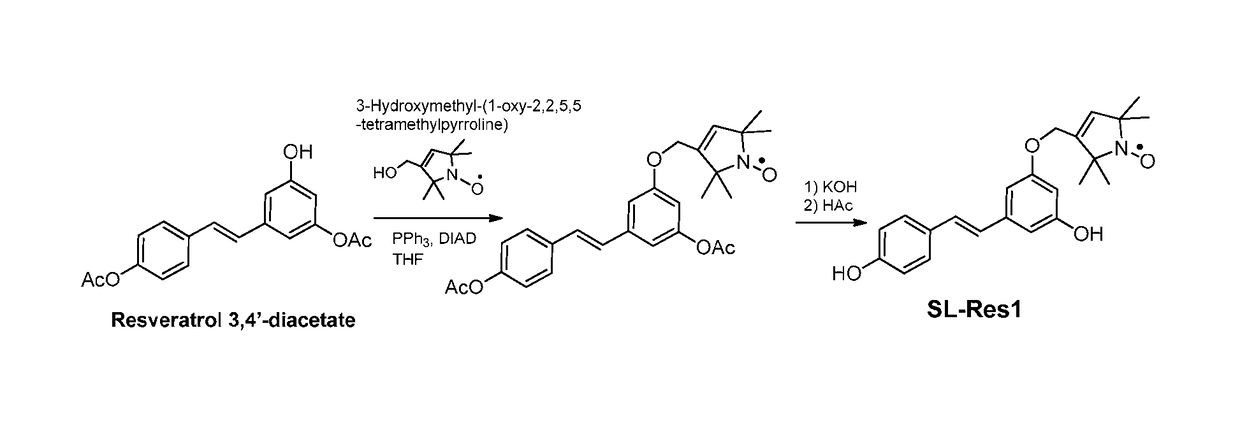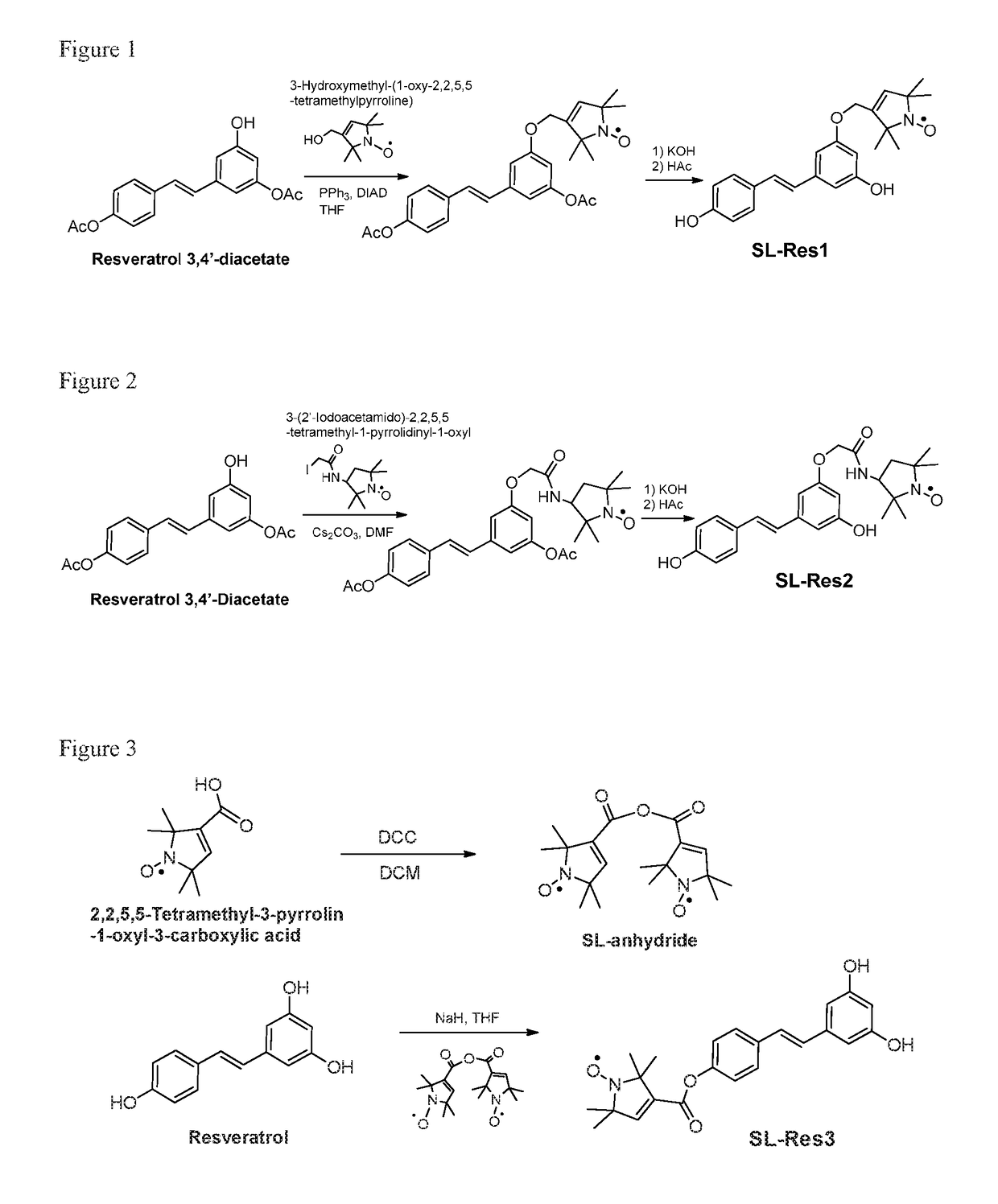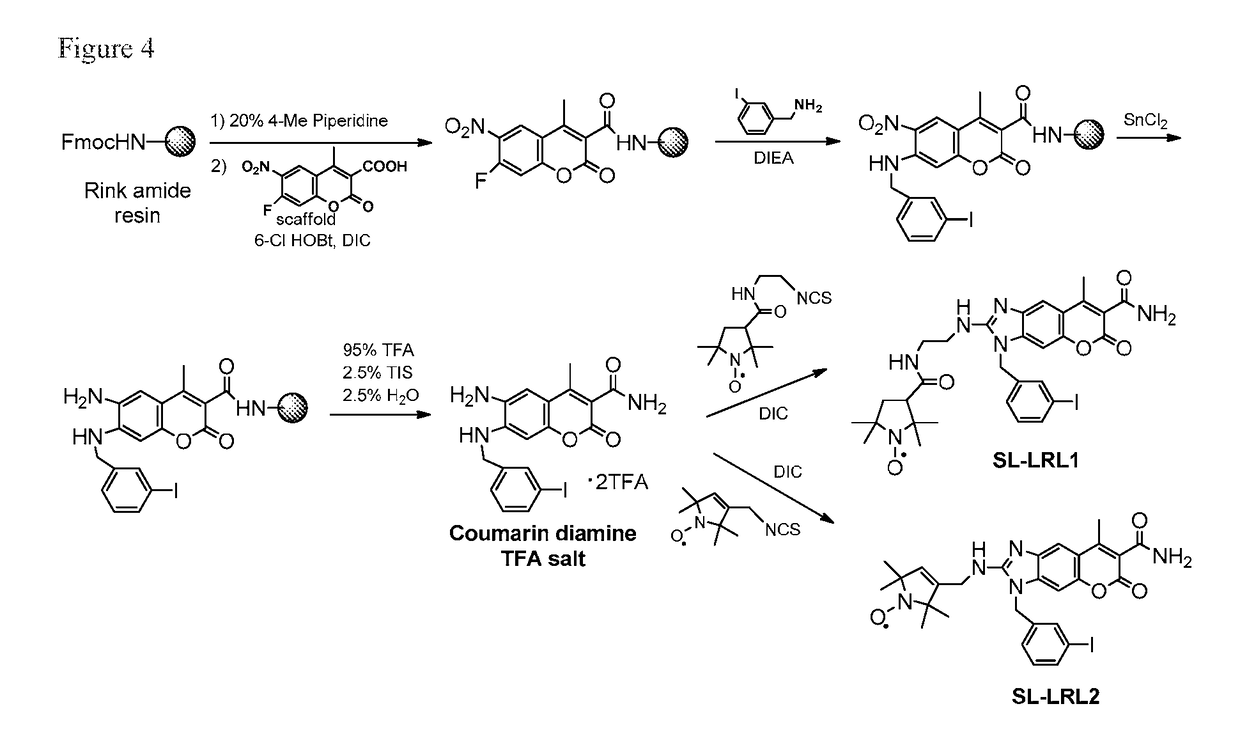Nitroxide containing amyloid binding agents for imaging and therapeutic uses
a technology of amyloid binding agent and nitroxide, which is applied in the direction of heterocyclic compound active ingredients, drug compositions, organic chemistry, etc., can solve the problems of cognitive function decline, limited availability, and limited clinical diagnosis tools
- Summary
- Abstract
- Description
- Claims
- Application Information
AI Technical Summary
Benefits of technology
Problems solved by technology
Method used
Image
Examples
example 1
(E)-3-(4-hydroxystyryl)-5-((2,2,5,5-tetramethyl-1-oxyl-2,5-dihydro-1H-pyrrol-3-yl)methoxy)phenol radical
[0130]
[0131]Synthesis was as shown in FIG. 1. To an 1.5 mL eppendorf tube was added resveratrol 3,4′-diacetate (Toronto Research Chemicals, Toronto, Canada, 8.3 mg, 0.0266 mmol), 3-hydroxymethyl-(1-oxy-2,2,5,5-tetramethylpyrroline) (5 mg, 0.0294 mmol), triphenylphosphine (PPh3, 8.0 mg, 0.0305 mmol), and anhydrous tetrahydrofuran (THF, 0.2 mL). The reaction tube was then lowered into a 42-kHz sonication bath (Cole-Parmer) and sonicated for 2 min. While sonicating, diisopropyl azodicarboxylate (DIAD, 6.6 μL, 0.0335 mmol) was added to the reaction mixture. The reaction mixture was sonicated for 25 min. The reaction mixture was added to KOH solution (20 μL, 10% aqueous solution) and then stirred for 30 min at room temperature. The solution was neutralized with 0.05% trifluroacetic acid (TFA) in acetonitrile and then submitted for purification with preparative reversed-phase high perfo...
example 2
(E)-2-(3-hydroxy-5-(4-hydroxystyryl)phenoxy)-N-(2,2,5,5-tetramethyl-1-oxylpyrrolidin-3-yl)acetamide radical
[0133]
[0134]Synthesis was as shown in FIG. 2. Cs2CO3 (20 mg, 0.0624 mmol) was added to a solution of resveratrol 3,4′-diacetate (13 mg, 0.0416 mmol) in anhydrous dimethylformamide (DMF, 1 mL) and the reaction mixture was stirred at room temperature for 45 min. 3-(2′-Iodoacetamido)-2,2,5,5-tetramethyl-1-pyrrolidinyl-1-oxyl (13.5 mg, 0.0415 mmol) was then added to the solution and the resulting mixture was stirred at room temperature overnight. The reaction mixture was added to KOH solution (20 μL, 10% aqueous solution) and then stirred for 30 min at room temperature. The solution was neutralized with 0.05% TFA in acetonitrile and then submitted for HPLC purification using above-mentioned conditions. The eluent was lyophilized to give powder SL-Res2.
[0135]The chemical identity was confirmed with Orbitrap ESI-MS, with a calculated mass for C24H29N2O5 of 425.21, and observed mass o...
example 3
(E)-4-(3,5-dihydroxystyryl)phenyl 2,2,5,5-tetramethyl-1-oxyl-2,5-dihydro-1H-pyrrole-3-carboxylate radical
[0136]
[0137]Synthesis was as shown in FIG. 3. 2,2,5,5-Tetramethyl-3-pyrrolin-1-oxyl-3-carboxylic acid anhydride free radical was first prepared by adding N,N′-dicyclohexylcarbodiimide (DCC, 56 mg, 0.271 mmol) to a solution of 2,2,5,5-tetramethyl-3-pyrrolin-1-oxyl-3-carboxylic acid, free radical (100 mg, 0.542 mmol) in anhydrous dichloromethane (3 mL). The mixture was stirred at room temperature for 1 h. The precipitate was filtered out and the clear solution was concentrated and dried over vacuum to the SL-anhydride.
[0138]To a solution of resveratrol (25.3 mg, 0.11 mmol) in 1 mL anhydrous dimethyl sulfoxide (DMSO) in round-bottomed flask was added sodium hydride (11 mg, 60% dispersion in mineral oil). The resulting mixture was stirred at room temperature for 20 min, followed by addition of spin-label anhydride (38.5 mg, 0.11 mmol). The reaction solution was stirred at room temper...
PUM
| Property | Measurement | Unit |
|---|---|---|
| Capacitance | aaaaa | aaaaa |
| Molar density | aaaaa | aaaaa |
| Molar density | aaaaa | aaaaa |
Abstract
Description
Claims
Application Information
 Login to View More
Login to View More - R&D
- Intellectual Property
- Life Sciences
- Materials
- Tech Scout
- Unparalleled Data Quality
- Higher Quality Content
- 60% Fewer Hallucinations
Browse by: Latest US Patents, China's latest patents, Technical Efficacy Thesaurus, Application Domain, Technology Topic, Popular Technical Reports.
© 2025 PatSnap. All rights reserved.Legal|Privacy policy|Modern Slavery Act Transparency Statement|Sitemap|About US| Contact US: help@patsnap.com



